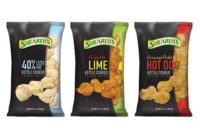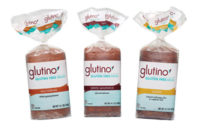While bakery volumes have been experiencing some heavy divots industry-wide, most bakers in the United States are benefiting from their products in key categories, as well as from their innovations and the strength of their brands. Up in Canada, however, not since the Atkins diet has the bread industry been hit so hard. Paul Hetherington, president and chief executive of the Baking Association of Canada reported in May that the current adversity to bread is different than when Atkins became popular because of several factors that probably won’t go away immediately, such as the damaged economy. Cash-poor consumers are more disciplined about not wasting food products.
“Bread is a perishable product, so if one is more careful with it, putting it in the freezer for example, it doesn’t go stale,” he says in a recent financialpost.com article. Dietary changes, the bad rap being taken by wheat products (deserved or not), and the surge in gluten-free diets by people not adversely affected by gluten have driven down conventional bread volumes. “There’s been a lot of pressure on volumes in the last couple years,” Hetherington says. “We are going to continue to see pressure on volumes throughout the year. I’d love to be able to say differently, but I don’t see that type of turnaround anytime in the near future.”
A squeeze on bread volume sales was also reflected in the corporate world as Maple Leaf Foods Inc. reported lower-than-expected first quarter adjusted earnings. Maple Leaf president and CEO Michael McCain says that bread woes are shared across the industry as “fundamental bread consumption is down.”
For Richard Lan, president and CEO at Canada Bread Co., Ltd., Toronto, that means taking a swing at the challenges head-on. “We are addressing the challenges and improving profitability through increased marketing, consumer outreach and cost reduction,” Lan says in a Canada Bread financial report for the first quarter of 2012.
Healthy choices, nutrition awareness
However, better-for-you ingredients, cleaner labels and smaller sizes are big winners in several bread aisle categories, and there is ample room for growth in these segments.
Nutrient awareness will only become more important as younger generations become more educated on health and nutrition.
Consumers are paying more attention to labels and ingredients, so clean labels are more prevalent. Clean labels are also a prime opportunity to tout the nutritional benefits of ingredients.
And that’s a good thing. According to a recent blog from the U.S. Dept. of Agriculture (USDA), negative health information about trans-fats, as well as labeling requirements, has shifted incentives for food manufacturers. According to the blog posting, the trans-fat content of new (including reformulated) products introduced from 2005 to 2010 is being lowered, as food companies are gradually reformulating their products by reducing and, in many cases, eliminating trans-fats.
The five product categories with the highest trans-fat contents tracked by USDA researchers were bakery products; prepared meals; desserts; processed fish, meat, and egg products; and snacks. But they found that trans-fat levels for new bakery products declined by 73%, however, from an average of 0.49 g. per serving in 2005 to 0.13 g. in 2010. New products in the other categories posted declines of around 50% over the same time period. Therefore, bakers are listening, and they’re also not boosting the levels of other ingredients to compensate for the lack of trans-fat.
The blog goes on to say that while some public health professionals worry that reformulated products with less trans fats may have higher levels of added sugar, saturated fat, or sodium, the researchers didn’t find this to be the case. When the researchers compared food products with and without trans fats, they found that new products without trans fats mostly contain less saturated fats, sodium and calories. “This suggests that food companies are generally substituting healthier ingredients for trans fats,” says the USDA, which has issued these findings and others in a new report called “New Food Choices Free of Trans Fats Better Align U.S. Diets with Health Recommendations.”
Healthier bars
And as our bars article in this issue emphasizes, more Americans are making changes to their diets to improve their health. Even more are trying to lose or maintain their weight, according to a 2011 International Food Informational Council Foundation study.
The focus on healthful eating is also broadening awareness around “all-natural” products, with the removal of high-fructose corn syrup and partially hydrogenated oils, and cleaner labels signifying that products have minimal ingredients. And women age 30 to 50 are the main demographic for these items. They are clearly looking for a healthy snack that’s light and portable to eat in the office or on the go.
In terms of bars, today’s consumers demand lower sugar versions, says John Leahy, president of Kind Healthy Snacks, New York City. “While our existing line of whole-nut and fruit bars contains only a moderate amount of natural sugars found in fruits and honey, we also wanted to expand our offering to meet the needs of consumers looking to lower their sugar intake even further,” he says.
Gluten-free factor
We’ve also learned that the huge growth in the gluten-free demographic shows no signs of slowing down, especially where taste technology is concerned. More advances in gluten-free products are providing innovation in the category.
For example, as demand for gluten-free products continues to expand, Udi’s Gluten Free Foods is broadening its product line beyond bread and bakery staples to reach consumers at more eating occasions. In March, the Denver-based company launched five new products during Natural Products Expo West in Anaheim, Calif: Vanilla cupcakes that are moist and delicious; Classic French dinners rolls, whole-grain seeded dinner rolls featuring chia, sunflower and flax seeds; frozen pizza in Pepperoni, Margherita and 3-Cheese flavors; and Muffin Tops, a tasty way to enjoy a gluten-free breakfast, in Blueberry Oat and Chocolate Chip flavors.
Says Denise Sirovatka, vice president of marketing, “Our goal is to create delicious, wholesome foods for all meals so gluten-free customers have the same eating and shopping experience as others.”
Udi’s thinks the gluten-free trend shows no signs of slowing down. To keep on top of demand, Udi’s says it focuses on innovation by creating foods with the taste and texture of conventional gluten-filled products.
The Muffin Tops and frozen pizza are now available in stores and the other products should be hitting store shelves next month.
Says Doug Radi, vice president of marketing at Rudi’s Organic Bakery, Boulder, Colo., “We continue to see increasing demand for gluten-free products that have the taste and texture of regular breads and baked goods. This allowed us to launch Rudi’s Gluten-Free Bakery nearly two years ago with three sandwich breads. Today, this line includes not only our breads, but also a pizza crust, hamburger buns, hot dog rolls and tortillas.”
Radi also says that consumers continue to want to learn more about what’s in their food and want to eliminate artificial ingredients from their diets. “We’re seeing a trend toward more healthful ingredients such as seeds and specialty grains,” he adds. “Rudi’s Organic Bakery has had a consistent focus on making the best breads with organic and natural (Rudi’s Gluten-Free Bakery) ingredients. We will continue to provide innovative new products to consumers across a broad range of product segments.”
Healthy, functional choices
As Radi indicates, healthy and functional ingredients, many of which are considered super foods, are being taken quite seriously by consumers and manufacturers. They can range from fruits such as acai and pomegranate to grains like quinoa and amaranth, to nutrients such as CoQ10, L-carnitine, Omega 3, resveratrol and vitamin K2. However, probiotics has. However, probiotics has been decreasing somewhat in popularity, ever since government regulations have come into play, points out Eric Kimmel, owner of Noble Foods Inc., a bar co-packer located in Quebec, Canada.
Making healthy choices and finding ways to eat better and promote a healthier lifestyle are on the top of consumers’ to-do lists. Dieting, vitamins, exercising, eating less and eating right, are all some of the well-known secrets to good health. So bakers and bakery product manufacturers are considering these points when rolling out new products.






